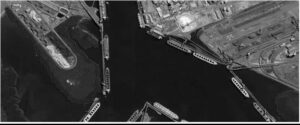By Hariesh Manaadiar
Harbour, Port, Terminal, Berth, Quay, Pier, Jetty – you are not alone if you are confused about these terminologies.

To many of us, these terminologies sounds the same.. It took me also a while to understand the difference when I started out in this industry.
So here’s how it all works.
Imagine this:
· A ship is bobbing in a large body of water like the ocean or sea.. Yonder is land where the waves are crashing and receding.
· The ship is filled with goods from foreign lands that could be traded with the inhabitants of the land.
· On land there are people with their own home grown and home made goods which they can trade with the people on the ship.
· What is standing between them meeting and carrying out this trade is this large body of water with no real meeting place..
Now imagine if there was a place where this ship could come in, be moored (tied up) allowing the people on the ship to come ashore or the people on land to go on board the ship.
Read Also: The Bill Of Lading And The Terms Of The Contract Of Carriage
Well, that place is called a HARBOUR.
Harbour
A harbour is basically an area filled with water sheltered by natural barriers like land and rocks or artificial barriers like breakwaters sometimes surrounded by tetrapods, that can provide a ship with safe anchorage and allow the transfer of goods and/or passengers between the ship and the shore.
Natural harbours are usually surrounded by land and this creates a protective bay making it a good anchorage point for ships.. Apart from coastlines around the world, natural harbours may also be found along fjords, coves, lake sides, lagoons and estuaries.
Some examples of natural harbours are San Francisco and New York in USA, Rio de Janeiro in Brazil, Sydney in Australia, Marmagao, in India, Saldanha Bay in South Africa.
Man used these natural harbours to enable trade between countries.. Although the formation may be natural, a lot of these natural harbours have been improvised upon, to be able to handle commercial activities.
Since natural harbours were not always exactly where he wanted it, man began creating artificial harbours to develop and improve trade.
These days artificial harbours can be created anywhere along the seaboard linking to industrial zones on land.
But of course it’s not that easy just to create a harbour.. A harbour needs to be deep enough to allow ships to enter and exit without touching the bottom of the sea bed while also providing enough space for the ships to turn and pass each other.
The bigger the capacity of the ships calling at the harbour, the deeper the harbour needs to be.
The act of keeping the shipping channels deep, wide and free of silt is known as dredging and is considered one of the main activities in maintaining a harbour.
Read Also:
Some of the hallmarks of artificial harbours are breakwaters, concrete walls (sea walls), and other forms of barriers designed to protect the harbour from storms and reduce the tidal range.
Such artificial barriers may also mean that the seabed in artificial harbours may be a bit more stable than natural harbours although this topic may be up for debate.
Some of the finest artificial harbours relying on a series of artificial breakwaters are Chennai in India, Jebel Ali in UAE, Long Beach in USA, Rotterdam in Netherlands.
Whether natural or man-made, harbours are important for trade and all around the world these harbours are used for the import and export of various types of cargoes such as steel, iron, oil, cars, clothing, etc etc.. Harbours also cater to cruise ships carrying passengers from place to place.
Some harbours may also be used by ships seeking shelter in bad weather etc, and these harbours may not have any kind of commercial or personal facilities and a ship can only just seek shelter there from the elements.
Port
When these harbours are used for the purpose of commerce and trade such as loading and unloading of cargo, passengers or anything that generates revenue, these harbours may be said to serve as a Port.
In short, a port is a place within the harbour where a ship can dock for a commercial purpose of either handling cargo or passengers or taking care of the ship’s requirements.
Ports play a very crucial role in transporting various types of goods and some ports are classified based on the cargo that they handle.
For example, there are ports that specialise in handling:
· Iron Ore – Port Hedland, Australia,
· Crude Oil – Ras Tanura, Saudi Arabia
· Grain – New Orleans, USA
· Passengers – Puerta Maya, Cozumel, Mexico
Port is also a place where water and land meet and therefore there are trains and trucks that come into the port for the purpose of delivery (for exports onto a ship) or picking up cargo (from imports off a ship).
Many countries have many ports along major rivers.. Mississippi River in the USA, Yangtze in China, Great Lakes in North America are some of the examples of major rivers having many ports.
Each of the ports are controlled, operated and run by a Port Authority which sets the commercial tariff for the handling of ships, goods and passengers at that port.
TO BE CONCLUDED NEXT WEEK
















Discussion about this post